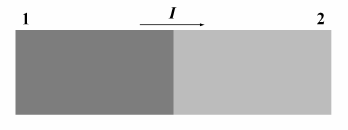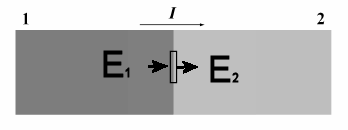Ohm's law, power
Problem:
A linear
accelerator produces a beam of electrons in which the current is not constant
but consists of a pulsed beam of particles. Suppose that the pulse current is
1.6 A for a 0.1 μs duration.
(a) How many
electrons are accelerated in each pulse?
(b) What is the
average beam current if there are 1000 pulses per second?
(c) If the
electrons are accelerated to an energy of 400 MeV, what is the average beam
power on target?
(d) What is the
peak beam power on target?
(e) What fraction
of the time is the accelerator actually delivering beam on target? (This is
called the duty factor of the accelerator.)
Solution:
- Concepts:
Basic concepts: Charge, current, energy, power.
- Details of the calculation:
(a) Q = 1.6*10-7 C/pulse, N = Q/(1.6*10-19
C) = 1012 electrons/pulse.
(b) Average beam current = Iavg = 1.6*10-7 C * 1000/s =
1.6*10-4 A.
(c) Average power on target
= 1012 * 400 MeV * 1.6*10-13 J/MeV / 10-3 s =
64 kW.
(d) Peak power on target =1012 * 400 MeV *
1.6*10-13 J/MeV / 10-7 s = 640 MW.
(e) Duty factor = 10-7/10-3 = 10-4.
Ohm's law, resistance, power
Two metallic spheres of the same radius r are immersed in a
homogeneous liquid with resistivity ρ.
What is the total resistance between two spheres? Assume that the distance
between two spheres is much larger than the sphere radius.
Problem:
A current I flows through a wire made of a piece of material 1 and a piece of material 2 of identical cross-sections A
welded end-to-end as shown in the figure. The resistivity of material 1 is ρ1,
the resistivity of material 2 is ρ2. How much electric charge accumulates at the boundary between the two materials?

Solution:
- Concepts:
Ohm's law, j = σcE =
E/ρ,
Gauss' law
- Reasoning:
The same current is flowing in each section of the wire.
- Details of the calculation:
I = jA, j1 = j2,
E1/ρ1
= E2/ρ2.
Apply Gauss' law to the interface.

E2 - E1 = σ/ε0, Q = ε0A(ρ2
- ρ1)j , Q = ε0I(ρ2
- ρ1).
Problem:
A copper wire (ρ = 1.72*10-8 Ωm)
has a length of 160 m and a diameter of 1.00 mm. If the wire is connected to a
1.5 V battery, how much current flows through the wire?
Solution:
- Concepts:
Ohm's law, resistance of a wire
- Reasoning:
The current can be found from Ohm's Law, V = IR. V is the battery voltage,
so if R can be determined, the current can be calculated. The resistance of
the wire is R = ρl/A.
- Details of the calculation:
For copper ρ = 1.72*10-8 Ωm.
The cross-sectional area of the wire is A = πr2
= π(0.0005)2 = 7.85*10-7 m2.
The resistance of the wire then is ((1.72*10-8)*160/(7.85*10-7))
Ω
= 3.5 Ω.
The current is I = V/R = (1.5/3.5) A = 0.428 A.
Problem:
One can locate resistivity anomalies in the ground as shown in the
figure below.

The current I flowing between electrodes C1 and
C2 establishes an electric field in the ground. One measures the voltage
V between a pair of electrodes, with P1 and P2 maintained
at a fixed spacing b. With b << a, V/b is equal to E at the position x. Anomalies in ground conductivity show up in the curve of as a function
of x.
Show that if the substrate conductivity is uniform and equal to σ, then
V/b = 2axI/[πσ(x2 - a2)2].
The electrodes are of finite size. However, you can perform the
calculation on the assumption that they are infinitely small, disregarding the fact that E
and j would then be infinite at their surfaces.
You can use the principle of superposition as follows.
The current in
the ground is the sum of a radial distribution emanating from C1 plus
another radial distribution converging on C2.
Solution:
- Concepts:
Conductivity, E = j/σc
- Reasoning:
The field in the ground is a superposition of a field E1
which points radially away from point C1 and a field
E2
which points radially towards point C2. Therefore the
current in the ground is the sum of a radial distribution emanating from
point C1 and another radial distribution converging on C2.
At some point a distance r1 from C1 and a
distance r2 from C2 we have
E = j1/σc +
j2/σc
= (r1/r1)I/(2πσcr12)
- (r2/r2)I/(2πσcr22).
- Details of the calculation:
On the axis at position x we have E = [I/(2πσc)][1/(x + a)2 - 1/(x - a)2]
i.
E = [I/(2πσc)](-4xa)/(x2 - a2)2
i
= -2axI/[πσ(x2 - a2)2]
i.
E =
V/b = 2axI/[πσ(x2 - a2)2].
Problem:
A high-voltage transmission line that connects a city to a power plant
consists of a pair of copper cables, each with a resistance of 4
W. The current flows to the city along one cable, and back along the
other.
(a) The transmission line delivers to the city 1.7*105 kW of power at 2.3*105
V. What is the current in the transmission line? How much power is lost
as Joule heat in the transmission line?
(b) If the transmission line delivers the same 1.7*105 kW of power at 110 V, how much power would be
lost in Joule heat? Is it more efficient to transmit power at high voltage or
at low voltage?
Solution:
- Concepts:
Circuits, voltage, current, resistance, power
- Reasoning:
Power delivered: Pdelivered = IV, Plost = I2R.
- Details of the calculation:
(a) The power delivered to the city, Pdelivered, is equal to 1.7*105
kW. The voltage V is equal to 2.3*105
V. The current through the cables therefore
is I = P/V = 7.4*102 A. This
current is flowing through the transmission cables. The electric energy
dissipated in the cables is equal to
Plost = I2R = (7.4*102)2*8
W = 4.4*106
W.
The power generated by the power plant therefore is
P = Pdelivered + Plost = 1.74*105 kW.
98% of the generated power is delivered to the city.
(b) The power delivered to the city, Pdelivered, is equal to 1.7*105
kW. The voltage V is equal to 110 V. The current
through the cables therefore is I = P/V = 1.6*106
A. This current is flowing through the transmission cables.
The electric energy dissipated in the cables is equal to
Plost = I2R = (1.6*106)2*8
W = 1.9*1013
W.
The power generated by the power plant therefore is
P = Pdelivered + Plost = 1.9*1013 kW.
Only 0.0009% of the generated power is delivered to the city.
Transmission of electrical energy at high voltage is much more efficient
that the transmission at low voltage. The voltage of the transmission
line is therefore reduced to 110 V as close as possible to the house of the
customer.



